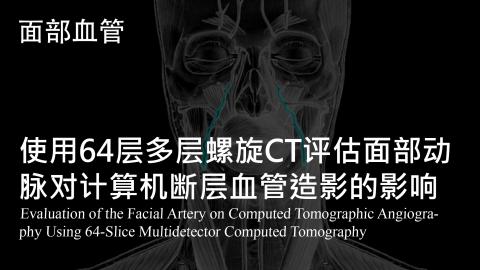
- 4601人
- 分享收藏
【面部血管文献】使用64层多层螺旋CT评估面部动脉对计算机断层血管造影的影响
Evaluation of the Facial Artery on Computed
简介
【 文献重点摘要 】
Background
Preoperative knowledge of a patient’s individual variations in facial artery anatomy would benefit plastic surgeons for reconstructive planning. The authors evaluated the feasibility of multislice computed tomographic angiography in vascular mapping of the facial artery.
Methods
In total, 187 facial arteries in 94 patients without facial tumor or vascular disease were studied. Anatomical variations of the facial artery were classified into four types: type 1, a short course that terminates proximal to the superior labial artery; type 2, an intermediate course that terminates distal to the superior labial artery near the nasolabial fold; type 3, a classic course that extends to the lateral nasal ala beyond the nasolabial fold with an angular branch; and type 4, duplex with dominant lateral angular branch. Facial artery patterns were compared with dominant patterns of the facial–submental artery bifurcation. The extent of the inferior and superior labial artery was evaluated separately.
Results
Sixty-four facial artery branches (34 percent) were classified as type 1, 74 (40 percent) as type 2, and 45 (24 percent) as type 3. Type 4 was seen in only four branches (2 percent). The facial artery was dominant in the facial–submental artery bifurcation in 84 percent of type 3 facial arteries. Three-dimensional volume-rendered images allow detailed visualization of the facial artery and its branches and help preoperative mapping.
Conclusion
Facial computed tomographic angiography allows detailed visualization of the facial artery and its branches and is a potential noninvasive imaging tool for preoperative vascular mapping for facial reconstructive operations.
背景
术前了解患者面部动脉解剖的个体差异将有助于整形外科医生的重建计划。作者评价了多层螺旋CT血管成像在面动脉血管标测中的可行性。
方法
对94例无面部肿瘤或血管病变的患者共187条面动脉进行研究。面动脉的解剖变异分为4种类型:1型,短程终止于唇上动脉近端;2型,中间路,终止于上唇动脉远侧,靠近鼻唇褶;3型,经典走行,延伸至鼻唇皱襞外的鼻翼,有角支;4型,双联,优势外侧角支。(3)面动脉的解剖变异可分为4种类型:1型,短程终止于上唇动脉近端,中间段终止于鼻唇上动脉远侧,靠近鼻唇皱襞,呈典型走行,延伸至鼻唇皱襞以外的鼻翼,有角支;将面动脉分型与面-跖下动脉分叉的优势分型进行比较。分别对唇下动脉和唇上动脉的范围进行评估。
结果
面动脉1型64支(34%),2型74支(40%),3型45支(24%),4型仅4支(2%)。在3型面动脉中,面动脉在面-腭下动脉分叉中占主导地位,占84%。三维体绘制图像可以详细显示面部动脉及其分支,并有助于术前测绘。
结论
面部CT血管造影可详细显示面动脉及其分支,是面部重建手术术前血管标测的一种潜在的无创性影像工具。



